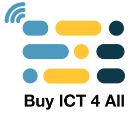“It all starts with policy” is a phrase that’s often stated. Does your current Information and Communication Technology (ICT) public procurement policy need attention in the area of accessibility for people with disabilities? This section of the Portal provides information on the many benefits of addressing ICT accessibility, and aims to help you review and adjust current policies in order to start realizing those many benefits.
To begin this section, two introductory guides provide background to the whole public procurement policy area, describing the main issues, and the primary support resources that are available. The first guide is written from the perspective of the “Smart Cities for All” project, and the second is written in support of implementation of the “UN Convention on the Rights of People with Disabilities” (CRPD). Both guides provide a useful introduction, even if your area of focus is beyond Smart Cities or the CRPD.
Next, the Model Policy can be considered the focal point of any effort to adopt ICT accessibility in any public procurement policy. The source material in the Model Policy can be used to modify or even replace current policies.
Finally in this section, for those who would like to know more about the history that preceded the creation of the model policy, we provide links to key articles that provided an impetus to the field by raising awareness of the potential benefits of meeting the needs of people with disabilities by improving public policy.
Guidance on Public Procurement Policies
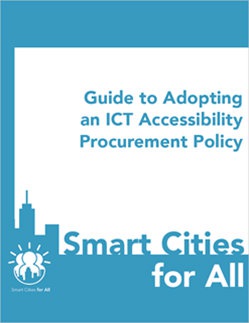
By: G3ict and World Enabled
May 2017 | English | Pages: 20
This short, concise guide was written as part of the Smart Cities for All project, but the content applies very broadly for any group that is interested in implementing ICT accessibility....

By: G3ict
October 2015 | English | Pages: 14
Following the ratification— by more than 170 countries—of the 2006 United Nations Convention on the Rights of Persons with Disabilities (CRPD), there have been numerous publications supporting...
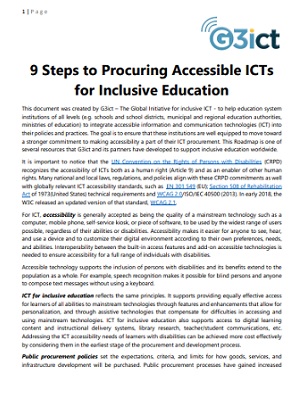
By: G3ict
September 2018 | English | Pages: 6
Increasingly, schools, school systems, and education ministries worldwide are investing in technology for their classrooms and learners..
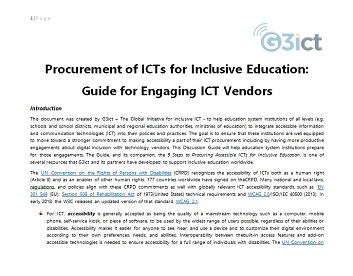
By: G3ict
September 2018 | English | Pages: 10
This discussion guide will help education ministries and school systems lead better discussions with technology vendors about accessibility and digital inclusion..
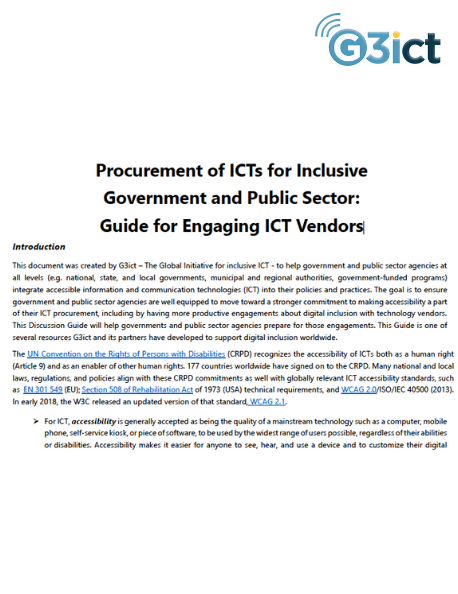
By: G3ict
January 2019 | English | Pages: 12
This Discussion Guide aims to help government and public sector agencies at all levels integrate accessible information and communication technologies (ICT) into their policies and practices.
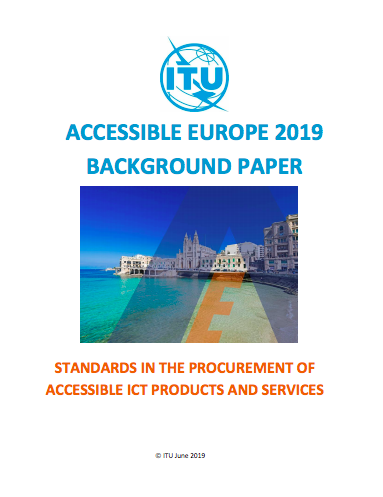
By: ITU
June 2019 | English | Pages: 31
This ITU Background Paper has been prepared by the ITU Consultant Mr Dónal Rice in collaboration with ITU-D & ITU-T focal points for ICT Accessibility & in coordination with the ITU Office for Europe.

By: UN ESCAP
2019 | English | Pages: 143
Disability at a Glance 2019: Investing in Accessibility in Asia and the Pacific focuses on the importance of increasing investment in accessibility and build an inclusive Asia and Pacific for all.
Model Public Procurement Policies
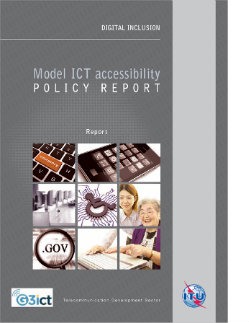
By: G3ict and ITU
November 2014 | English | Pages: 134
As countries began to ratify the 2006 UN Convention on the Rights of People with Disabilities (CRPD), there was a clear need for resources that would help with the implementation of the....
Additional Background on Public Procurement Policy

By: GSA Information Consultants and University of Wollongong
2013 | English | Pages: 14
This research paper on accessible procurement outlines some of the economic benefits of investing in accessibility through procurement processes. The authors explore some of the history of....
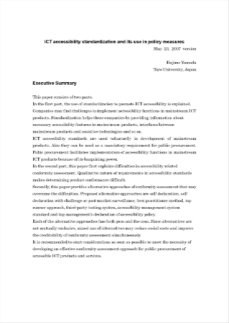
By: Tokyo University
May 2007 | English | Pages: 23
In this 2007 paper, the author argues that with ageing populations there is an increasing need for ICT accessibility, and presents examples from Japan...
Next Resource Subsection: ICT Accessibility Standards & Guidance

